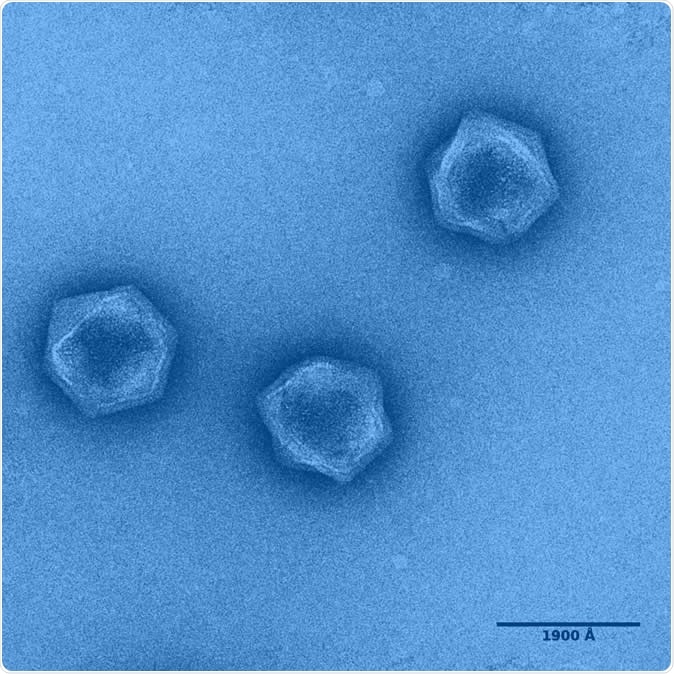According to researchers from Virginia Tech, genes within viruses possess certain portions that help them make their own tools for metabolism. However, they do not have metabolic processes of their own. The new study with these findings appeared in the latest issue of the journal Nature Communications.
This study showed that single-celled organisms such as algae are under the influence of certain giant viruses that carry the suitable genes that create tools for metabolism that the algae can utilize.
These giant viruses, the researchers explain, are mere envelopes containing the genetic code of either DNA or RNA. They are visible only to the electron microscope and contain hundreds of thousands of genes. Study leader, Frank Aylward, an assistant professor of biological sciences in the College of Science, said that these giant viruses are often missed by researchers because the sieves that separate viruses from bacteria may often filter out these giant virus particles and let in only the smaller viruses.
What was found?
The team of researchers explained that these viruses are found in large numbers in water organisms. They can infect algae and other single-cell organisms, such as protozoa. Algae and protozoa in the water have complex metabolisms that can influence their consumption of nutrients in their environment and also release waste materials found in the water bodies such as lakes, seas, and oceans. These also affect the carbon cycle of the earth, wrote the team.

'Brown tide virus' is a member of a class called the giant viruses. Researchers have discovered genes for key cellular metabolic cycles in many giant viruses, suggesting that these microbes may be interacting with their hosts in more diverse ways than previously thought. Image Credit: Dr. Chuan Xiao and Yuejiao Xian, the University of Texas at El Paso.
Why was this study important?
As the viruses possess vital sequences in their genes that can affect the metabolic functions of these single-celled organisms, so they can have a role to play in the carbon balance in nature. Aylward said, "They're all over the biosphere. It's just we haven't really paid attention to them." Monir Moniruzzaman, a postdoctoral researcher, was the first author of this new study. His mentor Aylward said, "Monir is the giant virus expert. He just wouldn't stop talking about giant viruses, so finally, I said, okay, we'll start working on them."
What was done in the study?
The team of researchers looked at databases of the metagenomes that were available. These databases contain genetic information from a large variety of organisms in different environments. Moniruzzaman specifically looked at the genetic sequences belonging to giant viruses. He combined the information from 501 giant viruses gathered from marine as well as freshwater habitats.
Those genomes contained the standard features you'd expect -- genes that direct the construction of the virus' protective shell, and that allow it to infect and kill its host.
They didn't expect to see so many metabolic genes. Metabolism, the collection of processes cells use to extract energy from nutrients, is a hallmark of cellular life, absent from viruses almost by definition. Nevertheless, these giant viruses seemed to have genes linked to several key metabolic pathways in living cells.
Implications
This study was not the first to note that metabolic genes were a part of the viral genome. However, the researchers explain that so many included functions were, for the first time, seen in giant viruses. They speculate that these genetic sequences may have been acquired from the host cells which the viruses infect and were a phenomenon when the viruses were taking up sequences of genes from their hosts
Both Moniruzzaman and Aylward said that these genetic sequences had their unique signatures and were clearly identifiable. Aylward said, "It implies that the viruses have had these genes for millions of years, even billions of years, and they're virus-specific metabolic genes." Both said that there was a specific purpose of these sequences, and they were not just flotsam in a huge array of genes. They speculate that these viruses could be altering the metabolisms of their host cells.
Aylward said, "Once viruses infect a cell, we can't think of the cell as being its own autonomous entity anymore. The fundamental aspects of cellular physiology are being rewired by these viruses upon infection." In doing so these viruses, "are significantly altering the course of life every day in the environment."
In science, the implications of this study are huge; they explain. The effects of the viral genome on the host cells could be studied and could have a broad impact on the environment. They added that this also deepens the understanding of what is alive (the single-celled organisms) and what is not (the viruses). Aylward said, "I think of these Venn diagrams, where it used to be that there was very little overlap, and the more we learn, the more they continue to overlap. Now it's gotten to the point where there are actually very few genes that are only found in cells, and very few genes that are only found in viruses. In terms of the genomic repertoires, they have much more in common than we would actually expect."
Moniruzzaman added, "Don't you think they're fascinating? I just think they're fascinating. They're just a bag of mystery. They're like a big forest and you are standing in front of the forest and you don't know what's in it. And I think this is the right time to understand it. I think they're mysterious, that's what I think."
Journal reference:
Moniruzzaman, M., Martinez-Gutierrez, C.A., Weinheimer, A.R., et al. Dynamic genome evolution and complex virocell metabolism of globally-distributed giant viruses. Nat Commun 11, 1710 (2020). https://doi.org/10.1038/s41467-020-15507-2